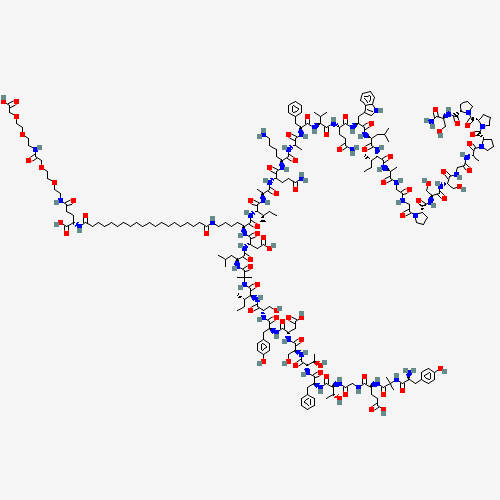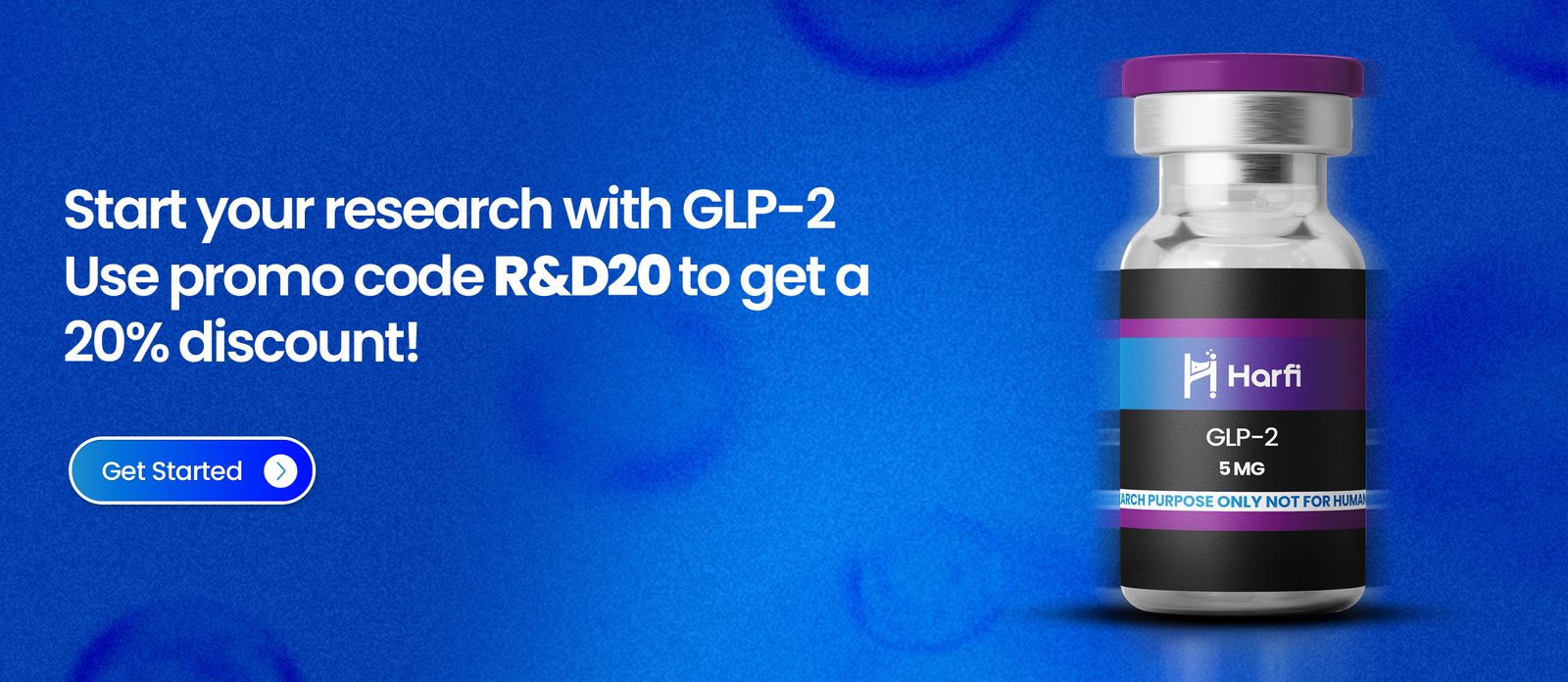GLP-2
GLP-2 is a synthetic compound based on gastric inhibitory polypeptide (GIP) and glucagon-like peptide-1 (GLP-1). It helps regulate blood sugar, improve insulin sensitivity, and support weight loss.
Product Usage
This product is intended for research purposes only. It is strictly designated for in vitro testing and laboratory experimentation. All information provided on this website is for educational purposes only. Any introduction into humans or animals is strictly prohibited by law. Only licensed, qualified professionals should handle this product. It is not a drug, food, or cosmetic and must not be misbranded, misused, or mislabeled as such.
Introduction
GLP-2 is recognized for lowering blood glucose levels, supporting weight loss, and enhancing insulin sensitivity. It is especially beneficial for managing type 2 diabetes and promoting cardiovascular health.
Structure
Sequence:YE-Aib-GTFTSDYSI-Aib-LDKIAQ (C20 fatty acid) AFVQWLIAGGPSSGAPPPS
Molecular Formula: C225H348N48O68
Molecular Weigh: 4813.527 g/mol
PubChem CID: 156588324
CAS Number: 2023788-19-2

Research on GLP-2
GLP-2, a peptide-based therapy, has shown significant promise in treating Type 2 diabetes. It enhances insulin secretion from the pancreas, leading to better glucose regulation. Studies have found that GLP-2 can lower hemoglobin A1c (HbA1c) levels—a key marker of long-term blood sugar control—by 2.4% after six months of use in individuals with Type 2 diabetes. Additionally, it has demonstrated a dose-dependent impact on weight loss, with some individuals losing up to 11 kg (25 lbs) over the same period.
Beyond its ability to increase insulin levels, GLP-2 also enhances pancreatic beta cell function, which plays a crucial role in insulin production and release. By improving beta cell health, it helps alleviate stress on these cells and may slow the progression of Type 2 diabetes.
GLP-2 responds to fluctuating blood glucose levels by increasing insulin secretion when glucose levels are high and reducing it during fasting periods, thereby improving insulin sensitivity over time. It also decreases fasting glucagon levels, which helps regulate liver glucose metabolism and prevents excessive glucose production. These combined effects contribute to GLP-2’s remarkable impact on glucose control and HbA1c reduction.
Mechanism of Action
GLP-2 functions as a dual agonist of the gastric inhibitory polypeptide receptor (GIPR) and the glucagon-like peptide-1 receptor (GLP-1R). This dual mechanism enhances its efficacy in treating Type 2 diabetes compared to traditional GLP-1 agonists. GLP-2 has a stronger affinity for the GIP receptor than the GLP-1 receptor. GIPR activation primarily stimulates insulin secretion after meals, while GLP-1R activation promotes insulin synthesis, increases pancreatic beta cell density, and supports beta cell survival.
Additionally, GLP-2 raises adiponectin levels—a peptide hormone that regulates fat metabolism. Higher adiponectin levels reduce fat cell formation, enhance energy expenditure, and improve insulin sensitivity. These effects contribute to a lower risk of Type 2 diabetes, atherosclerosis, and non-alcoholic fatty liver disease.
Impact on Hunger and Weight Management
GLP-2 initially slows gastric emptying, leading to prolonged satiety and reduced food intake. However, this effect diminishes over time due to tachyphylaxis. To counter this, a gradual dose escalation strategy has been shown to sustain delayed gastric emptying, helping individuals adjust their eating habits.
Unlike some GLP-1 analogues that may cause weight gain, GLP-2 is associated with significant weight loss over six months. Its GIP agonism plays a key role in this effect by improving insulin sensitivity in fat cells, reducing adipose inflammation, and increasing adiponectin levels. Additionally, GIP signaling in the brain influences hypothalamic feeding centers, decreasing appetite and promoting better glucose metabolism, which further contributes to weight loss.
Cardiovascular Benefits of GLP-2
Beyond its role in diabetes management, GLP-2 offers notable benefits for cardiovascular health, particularly by influencing adiponectin levels, lipid profiles, and inflammation.
Heart Health
Higher adiponectin levels, stimulated by GLP-2, are linked to a reduced risk of obesity, atherosclerosis, and heart disease. GLP-2 improves lipid biomarkers by lowering triglyceride levels and apoC-III, a key component in lipid metabolism. These changes help decrease cardiovascular risk. Increased adiponectin levels also support higher HDL (good cholesterol) levels and reduce triglycerides, both of which are protective against heart disease. Furthermore, adiponectin promotes cholesterol efflux from macrophages, reducing the likelihood of atherosclerosis.
GLP-1 and Cardiovascular Risk Factors
The GLP-1 component of GLP-2 helps regulate major cardiovascular risk factors, including hypertension, dyslipidemia, and obesity. GLP-1 signaling improves blood vessel function, leading to vasodilation, lower blood pressure, and enhanced organ perfusion. Additionally, it reduces inflammation, a key contributor to atherosclerosis.
Anti-Inflammatory Effects
Chronic inflammation is a significant factor in cardiovascular disease. This peptide’s GLP-1 activity helps mitigate inflammation by reducing NF-κB signaling, inhibiting inflammatory cytokine production, and decreasing the activity of inflammatory macrophages. These effects can persist for months following a single dose of a GLP-1R agonist like GLP-2.
Clinical Trials on Heart Failure
Ongoing clinical trials are evaluating GLP-2’s medium-term effects on individuals with heart failure, further highlighting its potential as a treatment option for cardiovascular conditions.
Conclusion
Initially developed for Type 2 diabetes management, GLP-2 has demonstrated significant benefits for cardiovascular health. Its ability to regulate blood sugar, enhance beta cell function, support weight loss, and reduce cardiovascular risk factors makes it a promising treatment option for individuals seeking improved metabolic and heart health.

DISCLAIMER: FOR INFORMATIONAL AND EDUCATIONAL PURPOSES ONLY
All articles and product details provided on this website are strictly for informational and educational purposes.
The product information presented here applies solely to in-vitro studies—experiments conducted outside of living organisms, such as in laboratory settings. These products are not classified as medicines or drugs and have not been approved by the FDA for the prevention, treatment, or cure of any medical conditions, ailments, or diseases.
Furthermore, the use of these products in humans or animals is strictly prohibited by law.

